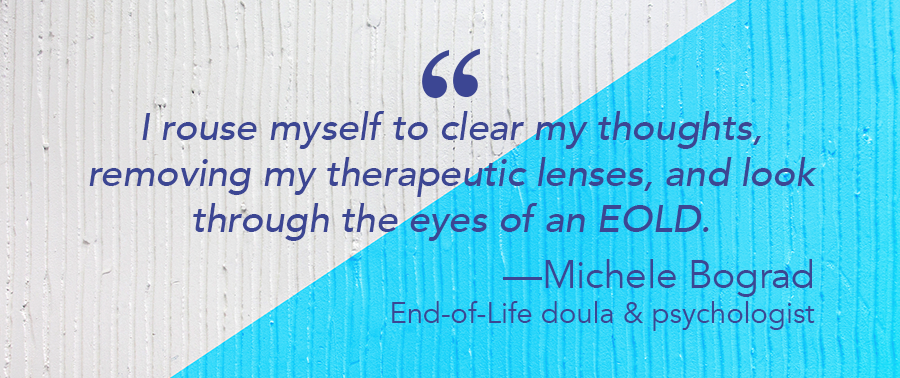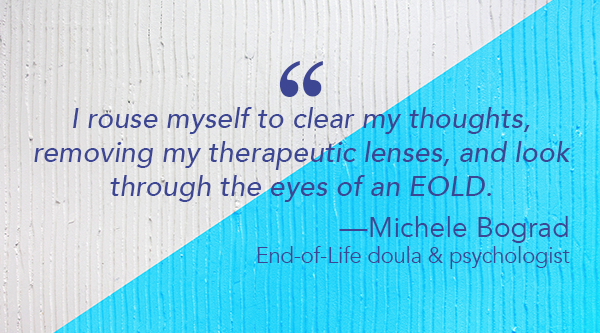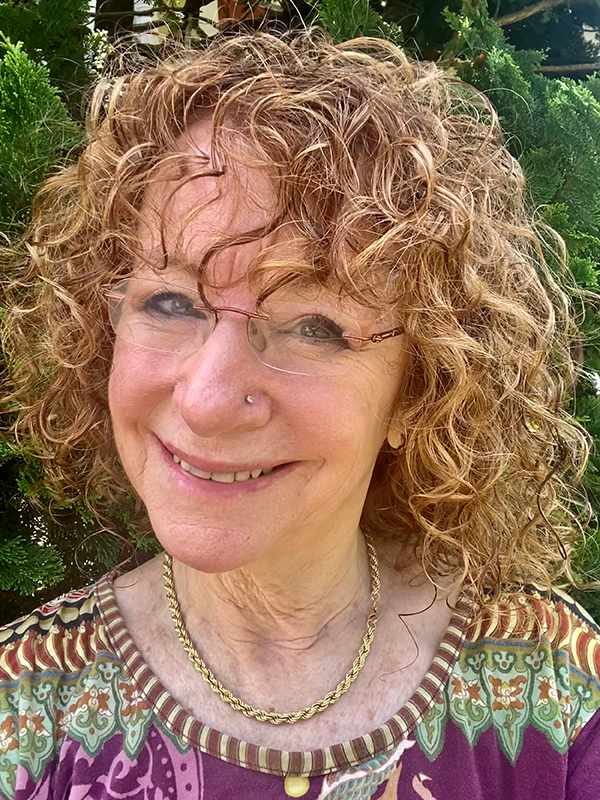Home > Wearing the Right Hat: Balancing Dual Roles as an End-of-Life Doula
Wearing the Right Hat: Balancing Dual Roles as an End-of-Life Doula
by Michele Bograd

Everyone who becomes an end-of-life doula brings their personal history of caretaking and helping others. We arrive, among other things, as parents or family members, as nurses or doctors, as teachers, as people in business, as members of service industries, and as psychotherapists. Who we are as EOLDs is strongly shaped by our professional identity and past training (and I include here parents and family members as unpaid givers and guiders). The ways in which we show up are influenced by how and whether we direct or shape people’s actions, our definitions of caring, the “goals” of the relationship, our strong ideas about successful outcomes, and how we think about hierarchy versus mutuality in connection, amongst other things. As EOLDs, we must carefully explore the intersection of our lifelong work and professions alongside the special nature and specific tasks of EOLDs.
Everyone who becomes an end-of-life doula brings their personal history of caretaking and helping others. We arrive, among other things, as parents or family members, as nurses or doctors, as teachers, as people in business, as members of service industries, and as psychotherapists. Who we are as EOLDs is strongly shaped by our professional identity and past training (and I include here parents and family members as unpaid givers and guiders). The ways in which we show up are influenced by how and whether we direct or shape people’s actions, our definitions of caring, the “goals” of the relationship, our strong ideas about successful outcomes, and how we think about hierarchy versus mutuality in connection, amongst other things. As EOLDs, we must carefully explore the intersection of our lifelong work and professions alongside the special nature and specific tasks of EOLDs.

As a psychotherapist with over 40 years of experience treating individuals, couples, and families (I am a licensed psychologist), I know my training and background have built many capacities that strengthen me as an end-of-life doula: holding space and stillness, the ability to tolerate intense emotions, quickly perceiving intrapsychic and interpersonal dynamics, great familiarity with human conflict and suffering. And yet, an end-of-life doula is not a psychotherapist. I’ve been pondering the question: What are the differences?
As I begin this exploration, a caveat and an invitation.
The caveat: There are many models of psychotherapy, and some overlap with some of the qualities and practices of “the doula heart.” And yet, there are important distinctions.
The invitation: If you are not a therapist, ask yourself: How do my personal and professional identities enhance my work as an end-of-life doula, and how do they get in the way of a doula heart?
As I’ve thought about this, I’ve struggled to discern: Where does being a psychotherapist and an EOLD overlap? And what do I need to learn about not being a psychotherapist to be a better EOLD?
Hierarchy: Teacher or Learner?
Sitting in the living room of a Cambodian family whose mother has end-stage stomach cancer, I hear the tensions between the traditional parents and the more assimilated children. I watch the gender dynamics as the sons make major decisions. Were they in my psychotherapy office, I would enter as a seasoned family therapist, help them determine their goals and desired outcomes, and bring strategies and clinical models I trust to orchestrate and create change. Even when I go by my first name, I am the doctor and the expert who is primarily responsible for the process.
There is a difference between a doula sharing important information and knowledge about dying and death, and a psychotherapist taking an expert position. Hierarchy is baked into our society and most of our professions such as teacher/student, nurse/patient, psychotherapist/client, parent/child. To counteract not only hierarchy but the model of “one who knows/one who needs to learn,” grief expert Alan Wolfelt coined the term “companioning”—a concept integral to EOLD work. In companioning, we are equals. Curiosity is the bridge. The helper/doula is a learner. We walk alongside, not lead.
Evaluation: Pathology or Existential Struggle
The woman, bedbound in her living room with COPD, shares her worry about her 50-year old son who recently moved in to take care of her. Marijuana wafts out of his bedroom and she alludes to a recent incarceration. When he sits in on our conversation, his energy is high and he jokes and distracts every time we begin to approach his mother’s not-too-distant death. In my head, I am toying with diagnostic categories, noticing patterns, thinking about his defensive structure, analyzing how his fear is keeping him distant from his mother in these last weeks. I rouse myself to clear my thoughts, removing my therapeutic lenses, and look through the eyes of an EOLD. I turn to them as a son trying his best to be with his dying mother.
A core feature of psychotherapy is assessment and evaluation of personality, resilience, interpersonal patterns, and addictions, among other things. This evaluation guides treatment and its goals. By definition, it is change-oriented—often toward what is deemed healthy or normative or “better.” Focus is on recovery. When it is used lovingly and wisely, assessment and evaluation are a worthwhile enterprise within psychotherapy. As an EOLD, we all judge and evaluate the people and families we serve. But at our best, EOLDs work with ourselves to suspend judgment. Regardless of who the people are that we are assisting, we are in the moment with them. That moment of facing death and loss is less about psychopathology than about human beings trying to weather the inevitable. There is also no right way, no fix. Whatever is happening is unfolding, and it is not our role to judge that it could be done better or differently. As EOLDs, not only do we not have the time or their permission to intervene, it is not our mission. Our mission is to hold and to be with—hard though that may be.
Goals: Intervening or Witnessing?
I’m sitting vigil with a man dying of pancreatic cancer. His grown daughter is very anxious and can’t focus on the present moment. In her agitated sharing, she alludes to past struggles with anxiety and to her daughter’s school refusal. My “therapist ears” perk up. I rein myself in. Rather than going into her past and opening up more exploration, I focus in on the present moment and gently focus her on saying good-bye.
In a joint meeting, I’m consulting as an EOLD to a psychotherapist and her client—a man with mesothelioma. As we’re talking about his end-of-life plans and his feelings about friends disappearing. It is clear that he is relatively passive in his relationships and doesn’t express his needs. I sit on my hands, feeling the pull to advise, to act on my curiosity about where he learned not to ask. Instead, his therapist leans forward and says what I would do in the same chair, “Where did you learn to deny your needs and be the good child?” As a doula, I remain attentive and silent.
I meet with the adult caretaker daughter of a charismatic patient with advanced prostate cancer who is adored by the hospice team I am part of. She bitterly expresses, “This wonderful guy you all love was a failure as a father.” As a therapist, I would open up this topic, elicit feelings, do something for sure. But as the hospice social worker reminded me, “Our job is to shepherd him through dying, not fix their relationship.”
One could say that a psychotherapist who is an EOLD doesn’t have the time to “fix their relationship.” More importantly, it is not within our job description. As I learn more about the practice of being an EOLD through immersion with those who are dying and their loved ones, I am aware that my impulse to fix or repair is well intended, but keeps me from opening myself to the present moment, to what is unfolding in this person and in this family that has a far longer history than I know or can comprehend, that “being with” is not second best to catalyzing change. Instead, my steady, open presence helps create a container for holding. Intervening is striving; witnessing is spacious and grounded…and very tough to learn and to believe is enough.
Time: Completed Process or Momentary Grace?
I am talking to a psychotherapist colleague about a woman I met as an EOLD one day before her husband died of early onset dementia. She was struggling with losing the man she loved and yet wanting this version of him to be gone. The several hours we shared were intense, sacred, and useful as she spoke the unspeakable. I was holding this close as I spoke to my colleague, who responded, “Too bad. You didn’t have enough time to accomplish anything with her.”
A hallmark of psychotherapy is time. Whether one practices short- or long-term psychotherapy, we expect consistency and continuity over time. This idea of a relationship and change unfolding over time is closely tied to the idea of outcome. Psychotherapists focus on the past to change the future. We explore patterns to modify them. The enterprise is about moving forward and exemplifies the all-American ideal of progress. For example, an article about psychotherapy with the dying states that the goals of therapy with dying patients are more modest because of the “limits of possible change.” In contrast, even though some EOLDs track people over months of dying, at its best our focus is on the moment, uplifting the here and now, the living until dying. We are aware that sometimes, not always, the imminent horizon catalyzes unexpected change and even transformation. But simultaneously, we hold that this is not the goal of being an EOLD. The single moment, be it sitting vigil, comforting the bereaved, giving people who are dying a map that eases their fear—each of these moments are precious in and of themselves. Not changing, not growing, not suffering less—these are also experiences honored by an EOLD. As Wolfelt writes in his book Companioning the Bereaved: A Soulful Guide for Caregivers, “Going into wilderness of the soul with another human being is not thinking you are responsible for finding the way out.”
The End: Orchestrated or Unexpected?
It’s clear that the patient, a 70-year old woman with advanced lung cancer, is grateful for our frank conversation about death. “I deserve to be able to talk about this when I want to!” she declares testily to her family. It is equally clear that her husband is very uncomfortable with our discussion. “You’ve got plenty of time ahead,” he murmurs. She eagerly scheduled our next appointment, but he calls to say they won’t need my services, as “we’re able to talk about these things ourselves.”
The family members supporting the very slow decline of a 75-year-old with renal failure were grateful for my weekly visits with him but were growing overwhelmed and weary of what his caretaking demanded of them. Unexpectedly, I learned that they left my hospice system and transferred to a Veterans Administration facility. Quickly, they were under the care of a new team. I texted once with his daughter but had no more contact with the patient I had met with for six months who died several weeks later.
“Good endings” are a goal of many models of psychotherapy, as it is an opportunity to help people mature into facing losses and to appreciate what they can handle on their own. It is a time for reflection on what was accomplished, what remains to be worked on in everyday life, celebrating the gains and healing, processing disappointments, and saying good-bye. Given my father’s sudden death when I was young, I also have personal reasons for creating careful terminations with my clients. Though occasionally a client will leave therapy abruptly, almost always I’m able to orchestrate a good ending. As an EOLD, that often doesn’t happen: People may die unexpectedly; a family doesn’t want the doula anymore; people change medical teams or are not recertified for additional hospice care.
I am jarred by that abruptness and uncertainty and humbled by my lack of control. Things are left unfinished. I cannot orchestrate a fitting conclusion. What is a doula to do? My consultant, Dr. Jamie Eaddy-Chism, confirmed that, by definition, all EOLD work ends but often not in predictable or mutually acknowledged ways. My learnings from her:
1) Find a way of ending every doula meeting as if it is the last, although not heavy handedly. Instead, hold close that every encounter could be the last—so what can I say that speaks to what we have shared together that day?
2) Try to cherish the piece of the journey I was part of and have it be enough. We don’t travel the full arc. Rather than seeing something as incomplete, hold I am present for what I am present for—and that is sufficient.
3) Create a personal, private ritual of my ending with someone, even if we do not end together. Write a letter not to be sent, light a candle, reflect on the gift of what we shared, let go of what was not done or the complications not navigated gracefully. Endings are so different for an end-of-life doula and a therapist.
I have written this article as a psychotherapist and EOLD. My hope is these words reach more than psychotherapists. Each of us has professional training, areas of expertise, life experiences that greatly enrich our work as EOLDs. But those same things can lessen our ability to truly be present, to learn the challenging lessons of growing the doula heart. Wolfelt states it strongly: People working in the end-of-life space must “stay in touch with their hearts without being contaminated by the formality of professional training.”
Author Bio:
Located in Massachusetts, Michele Bograd is a psychologist and an INELDA-certified EOLD. She can be contacted via her site.

